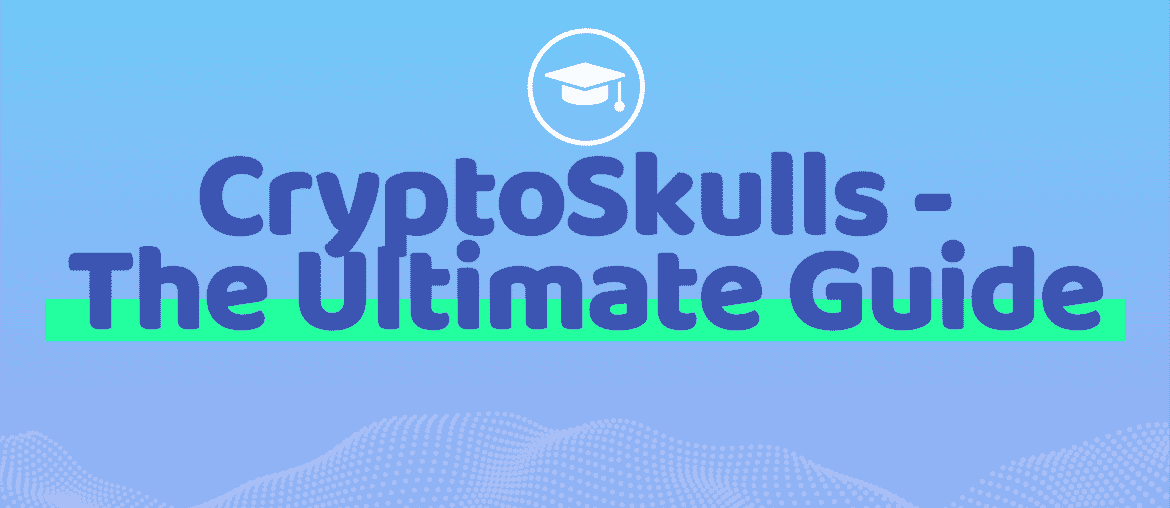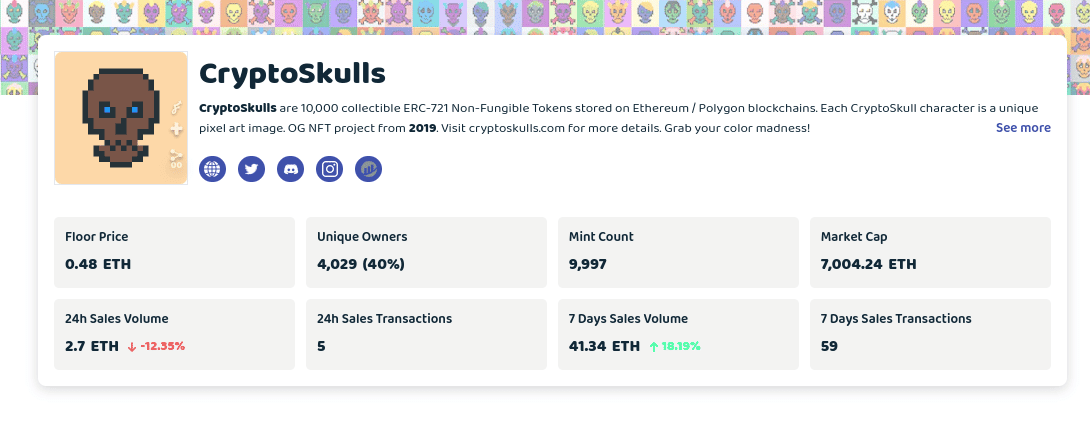Called an “OG project” of the original crypto space, CryptoSkulls may be an NFT name you see back in headlines. But they are certainly not a newcomer to the page. CryptoSkulls, which features 10,000 skulls, digitized in rough eight-bit style, started its adventure back in 2019.
In terms of crypto, this makes it about as old-school as it comes, as the NFT marketplace, which recently is seeing a resurging boom, is still in its very early stages of development. The CryptoSkulls NFT project creates a unique opportunity, not commonly found in the industry.
Not only are the NFTs collectible, tradable, saleable, and, well, just plain fun, they are also used for playing an online game. NFTs as part of game development is still a new concept, but new players are entering the scene daily. What does the CryptoSkull history show us?
Let’s dive into the product, how it works, and what fuels its popularity. Pull up a chair and learn how this skulls game has left its mark on not only an NFT space but also in the world of online gaming.
Table of Contents
What Is a CryptoSkull?
In practical terms, the CryptoSkull itself is a simple NFT. Each individual image is represented by an NFT, or non-fungible token. However, these NFTs were like none the market had seen before its time.
A Game or an NFT?
The NFT being purchased is also used in an online game, which was released in October of 2o20. This game is called Gold of Skulls. We will dive more into the game soon, but for now, it is crucial to understand there are two ways of looking at a Cryptoskull NFT.
To Be Used as an NFT
For one, the NFT is just that, a non-fungible token that can be bought, sold, and traded on an open exchange. It has no token or asset of equal value. By definition, it is a token that represents a digital asset. The NFT uses blockchain technology to verify and secure transactions.
If you aren’t familiar, a blockchain is a distributed ledger, that is decentralized, and possesses no centralized authority. While some networks are backed by a corporation, a bank, or a government, overseeing its transactions, a blockchain instead relies on a peer-to-peer network to oversee the comings and goings within the network.
To Support Game Development
For those seeking to play Gold of Skulls, these NFTs are required for in-game operation. Every skull is playable in the game.
Players were able to purchase the game tokens prior to the game’s fall 2020 release. Once inside the game, the rarity of the token was actually taken into account with gameplay development.
The Gold of Skulls game was the first game where the uniqueness of the collectible token impacted the uniqueness of the player within the game. Many called the development “revolutionary,” including Cryptoskull’s own website.
To support game development, the creators of CryptoSkulls marked 1,000 CryptoSkulls as “Game Token” pieces, allowing owners of these specific tokens to have extra features once in the game.
The CryptoSkull Logistics
From what they are to how you find them, there is a lot to learn about the CryptoSkull itself. Let’s break down what precisely we are talking about in this unique NFT.
Where To Buy CryptoSkulls
CryptoSkulls are 10,000 collectible ERC-721 non-fungible tokens (abbreviated NFTs). These tokens are stored on the Ethereum and Polygon blockchains. In other words, the Cryptoskull NFTs operate using the tech of these two, popular, open-source blockchains.
As of publication, the CryptoSkul ERC-721 items can be purchased on OpenSea, Rarible, and LooksRare platforms for purchase.
How Unique Is Your Skull?
The CryptoSkulls concept has been around since 2019. Each CryptoSkull character itself is a unique pixel art with a “Uniqueness Index” property. In other words, each of the 10,000 images is ranked by how unusual and strange it is (yes, perhaps in the eye of the beholder).
This UI property shows the total rareness of all image features. CryptoSkulls with rarer features have less Uniqueness Index and are often more desirable and expensive.
Skull Lords
For example, of the 10,000 images include only TEN unique pieces called Skull Lords. These ten CryptoSkulls are legendary, hand-drawn images. Their Uniqueness Index is 1, as they are an extreme rarity.
Boiled down to probabilities, gamers had a one in one thousand chance ever landing a Skull Lord upon the initial release. Today, these ten unique giants in the CryptoSkulls NFT collection are among the most sought after to this day.
What You Own
When you purchase an NFT through CryptoSkulls’ NFT platform, this playable token includes some basic rights.
Full Commercial Rights
CryptoSkulls owners have full commercial rights to the art in their owned wallets. No other person can own the exact same art. As defined by an NFT itself, it is a digital asset that cannot be replaced, copied, or owned by any other person.
Merchandising, Derivatives, and Commercial Use
There are no monetary limits on earnings on merchandise, derivatives, or other commercial uses, according to the company’s website. In other words, no caps have been placed on these NFTs, and the sky is the limit when it comes to the wide variety of uses, earnings, and placement that an owner can have with an owned CryptoSkull.
Copyright Transfer
While it has not had the chance to stand up to legal challenges just yet, the CryptoSkull developers feel that such red tape is not required.
“It is our opinion that a blockchain transaction satisfies the legal requirement for copyright transfer,” states the CryptoSkulls own website.
Behind this belief, CryptoSkull founders state that the copyright ownership of each individual image is “adjudicated by the Ethereum/Polygon address for which the non-fungible token (NFT) of that image is assigned.”
Once there is a transfer or sale of the NFT to a new owner, however, the previous owner then gives up all claims to the copyright. That new, unique owner will have said rights at that time of purchase.
The Uniqueness of the CryptoSkulls NFT Project
CryptoSkulls is a rather landmark case for the NFT space for a number of reasons. Many experts are just now diving into the developer, its sales, and its craze driving up the Ethereum blockchain popularity even higher.
Gaming with Tokens
For one, as we’ve mentioned, the use of tokens not only as investments but also as game pieces was a concept that had not been tried prior to its invention. Those in the gaming circles became interested in this news, and users could cross genres, from NFT investing to online gaming.
A Rediscovery
And, while its inception dates back to 2019, this system of NFTs got off to a remarkably slow start. Somehow, however, digital art has taken off in recent months, as NFT collection comes more into the mainstream. With a January 2022 trading volume topped out at $44.65 million in just one week, this project is being called “rediscovered” by the industry.
Many are dusting off their skulls and sparking an interest once again in this phenomenon, creating a value growth that was once thought lost. This market is once again active, and if by chance you were someone that was lucky enough to snatch up a CryptoSkull years ago, you might want to do a search and price check on its value.
If the January 2022 boom of sales is anything to note, reviving a payment token of a once-thought dead-in-the-water project is another landmark this case can add as a feather in its cap.
The Future of CryptoSkulls
There is a risk in any investment, but those that took a shot purchasing a goofy, pixelated skull three or more years ago may want to research some updated data. That same money you put out not so long ago may be your ticket to paradise, should you cash in on your newly valuable skull.
There comes a point, however, where every investment hits its sales cap. If January 2022 was the peak of all activity, it may mean that this once-active game of NFTs is on its way out.
But, if you are ready to risk your crypto, seeing the name in the news of a now three-year-old company revived into the headlines might be the only inspiration you need to revamp your CryptoSkull collection.
From creating a playable token to offering in-game rewards, CryptoSkulls surely has (and still may) made its mark on the NFT universe. Dubbed an “OG project,” this set of unique pixel art image collections is certainly one to keep an eye out for in years to come.
No one knows when a once-thought-dead NFT can come “back to life.” Perhaps that is the motivation behind the skull concept?






